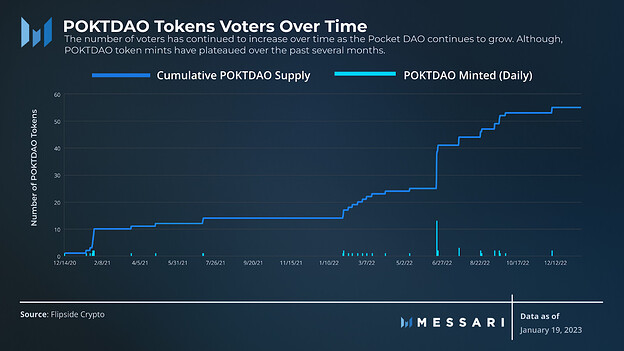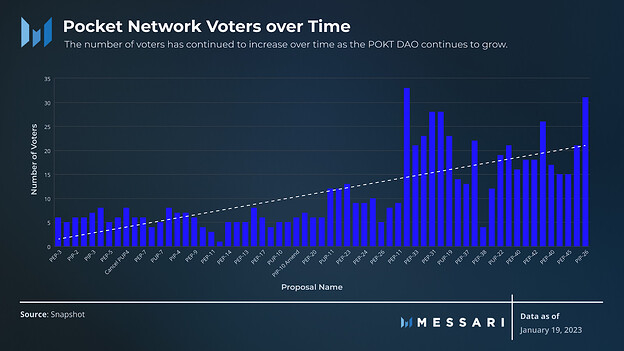gm Pocket DAO!
I’m a governance analyst on the Messari Governor team, and we’ve been covering Pocket DAO governance as part of our daily coverage for the last few months.
Due to the level of engagement and thoughtful governance discussions on this forum, @tnorm and I decided to dive deeper and analyze Pocket DAO’s unique governance structure and process.
We enjoyed writing about the unique proof-of-participation model that your DAO utilizes to empower its members to earn their governance voting power. From our vantage point, there seem to be a lot of benefits to this model compared to token-weighted governance models.
The full analysis (Pocket DAO: Exploring Proof-of-Participation Governance) is not paywalled on Messari, so all Pocket DAO members can read it for free!
Teaser
We hope you enjoy reading the full article on Messari, but if don’t want to make the click, here’s a quick teaser of the first part of the article:
Pocket DAO: Exploring Proof-of-Participation Governance
Key Insights
- Decentralized Physical Infrastructure Networks (DePIN), such as Pocket Network, are becoming more critical for Web3 protocols seeking a decentralized technology stack instead of relying on centralized Web2 cloud service providers.
- Pocket DAO’s governance structure presents a unique case study in protocol governance. Despite only minting 55 governance tokens to date, Pocket DAO governance remains exceptionally active, with more than 50% engagement on some of the DAOs most recent votes.
- A proof-of-participation model creates a uniquely flat power dynamic in DAO governance and contributes to a strong technical foundation, which may allow the DAO to explore new primitives in on-chain identity and governance.
… Voter Analysis
The Pocket Network’s unique governance structure lends itself to an equally unique set of data points. For example, most DAOs are hyper-focused on raising growth and participation. However, at Pocket DAO, only 55 POKTDAO governance tokens have been minted to date. While the DAO governance remains exceptionally active, the DAO’s onboarding has largely stagnated, and the DAO has hardly minted POKTDAO tokens over the past few months.
The limited supply is partly by design. One of the most significant roadblocks to one-person-one-vote is the Sybil problem, which arises when a single entity can create multiple identities to manipulate the outcome of a network’s decision-making.
Pocket DAO has opted to fight the Sybil problem by introducing proof-of-participation friction. This friction ensures prospective DAO members demonstrate skin in the game by completing any of the four proof-of-participation paths.
Despite being unable to verify that no Sybil attacks have occurred, voters’ growth rate in Pocket DAO appears non-indicative of Sybil attacks recognized in other DAOs. However, this is not to say that misaligned actors will not test Pocket DAO’s Sybil resistance in the future.
Pocket DAO’s power dynamics also create a deflationary effect on a single voter’s influence. As more members join the DAO, each voter’s influence decreases. In theory, this dynamic could deter existing voters from empowering new voters as their share of voting power slips with each new POKTDAO holder.
Concerning governance tokens, often, when calculating each wallet’s executed voting power (an individual’s executed voting power divided by the DAO’s total exercised voting power), the governance influence of whales reveals their highly disproportionate power over historic votes. For example, in our 2022 Optimism governance report, it was discovered some delegates held up to 15% of the total executed VP to date. In contrast, in Pocket DAO’s egalitarian governance, the highest percentage of voting power executed over all Pocket DAO votes to date is 6.72% from voter 0xc009…75FD.
Impressively, participation in Pocket DAO has continued to increase despite the slowing on-ramp of new DAO members. With only 55 POKTDAO tokens minted, the fact that the DAO has attracted over 50% participation on more than one occasion is noteworthy.
… To finish reading this analysis head over to Messari.

